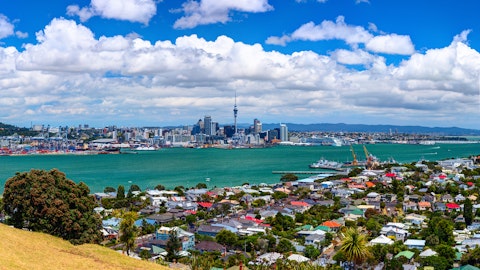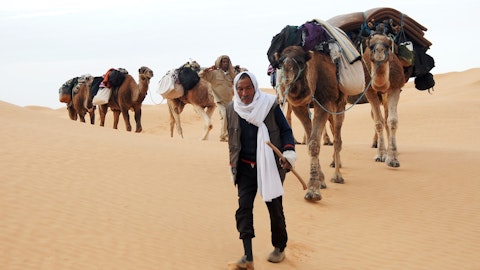When it comes to ranking the most livable countries in Africa, what would be the best way to gauge livability? In an economically-challenged region, should the sole deciding factor for a nation’s livability be economic competency?
Surely, it has got to be more complex than that. After all, there is more to what constitutes to a country’s livability. Different organizations gauge livability differently. For instance, The Economist Intelligence Unit (EIU) that appeared in our article – The 11 most livable cities in the world – used factors like governance, infrastructure, healthcare services, public transportation, and education among others.
For this list, we used the standards and rankings on the latest 2015 Human Development Index (HDI) by the United Nations Development Programme (UNDP), released 16th December 2015.

Oleg Znamenskiy/Shutterstock.com
The HDI is an annual statistics that uses three key factors to measure a nation’s level of human development and livability: longevity (life expectancy at birth) index, education (mean years of education and expected years of schooling) index, and the income index measured via Gross National Income (GNI) per capita. The concept of the HDI was developed by Pakistani economist, Mahbub al Huq, and has been published by the UNDP annually since 1990. The statistics is often framed on the premise of how easily people can achieve their desires through what is available in their country. The HDI is also used to determine whether a country is developing, developed, or highly developed.
It is important to note that none of the countries listed here made it to HDI’s Very High Human Development category, and as such, the standards of what is ‘most livable’ in these African countries are relative to the rest of the region.
So, what are the most livable countries in Africa by Human Development Index (HDI) standards? Check out the rest of this list!
11. Namibia
Overall rank: #126 of 188
HDI Values: 0.628
GNI per capita: $9,417.8
The Southern African country, whose economy largely depends on agriculture and mining, picked up the 11th spot along with Morocco. Namibians are expected to attend school for 11.3 years, and the literacy rate is at 76.5% in 2015. The nation’s life expectancy at birth is 64.8 years.

11. Morocco
Overall rank: #126 of 188
HDI Values: 0.628
GNI per capita: $6,850.1
The northern African nation has its booming tourism to thank for its recent successes economically and its small but significant rise in HDI values for 2015. Life expectancy at birth in Morocco is listed at 74, and Moroccans are expected to be at school for an average 11.6 years.

laranik/Shutterstock.com
10. Cabo Verde
Overall rank: #122 of 188
HDI Values: 0.646
GNI per capita: $6,094.2
The Portuguese-speaking island nation in the Atlantic Ocean is one of the most developed countries in Africa. Its HDI ranks have been on a steady rise since the year 2000. Life expectancy at birth of Cabo Verdeans is listed at 73.3 years and citizens are expected to be in school for 13.5 years. Despite having to import most of the necessary products, the Cabo Verde economy thrives thanks to a strong commerce, public service accounting, transport and other related industries.

Guido Amrein, Switzerland / Shutterstock.com
9. South Africa
Overall rank: #116 of 188
HDI Values: 0.666
GNI per capita: $12,122.30
South Africa is not only one of the largest nations on the African continent; it also has the second largest economy in the entire continent and second only to Nigeria. However, despite the size of its economy, it suffers from massive income inequality and poverty as well as unemployment. According to data from the World Bank, it has one of the widest disparities between its GNP and HDI rankings. Life expectancy at birth is 57.4 years and expected length of education is 13.6 years.

PhotoSky/Shutterstock.com
8. Gabon
Overall rank: #110 of 188
HDI Values: 0.684
GNI per capita: $16,366.9
Gabon’s economy is largely propelled by the oil industry but other industries – mostly in the natural resource-extraction – also thrive. The expected years of education is listed at 12.5 years and the average Gabonese is expected to live for 64.4 years.

cribe/Shutterstock.com
7. Egypt
Overall rank: #108 of 188
HDI Values: 0.690
GNI per capita: $10,512
Despite the political instability that Egypt experienced in the past years, this Middle Eastern country has experienced a rise, albeit slight, in its HDI estimates though it did not move in rankings from the past year. Life expectancy at birth in Egypt is 71.1 years and Egyptians are expected to be in school for 13.5 years.

Juan A. Valino Garcia / Shutterstock.com
6. Botswana
Overall rank: #106 of 188
HDI Values: 0.698
GNI per capita: $16,646.2
Botswana’s economy is one of Africa’s most impressive success stories. From being one of the world’s poorest countries, it elevated itself into one of Africa’s most developed nations thanks to a large deposit of diamonds and precious metals. But its livability is greatly hindered by its healthcare and longevity issues, being one of the countries that are most affected by HIV/AIDS epidemic. It is estimated that a quarter of the country’s over 2 million population is infected with the virus. Botswana’s citizens have an average life expectancy of only 64.5 and are expected to be in school for 12.5 years.

Sam DCruz / Shutterstock.com
5. Tunisia
Overall rank: #96 of 188
HDI Values: 0.721
GNI per capita: $10,404.5
Tunisia’s diverse economy has been experiencing a steady growth since 1990, but rampant corruption has had its adverse effects. Despite that, it is still one of Africa’s most competitive countries economically; in fact, it was ranked as Africa’s most competitive in 2009. The country’s life expectancy at birth is listed at 74.8 years, and Tunisians are expected to have 14.6 years of education.

posztos/Shutterstock.com
4. Libya
Overall rank: #94 of 188
HDI Values: 0.724
GNI per capita: $14,910.9
Libya’s economy largely depends on their oil industry having the largest reserves in all of Africa. The economy had experienced a significant plunge in 2011 after a massive political unrest situation but improved soon afterwards. However, there was a slight decline in HDI rankings for the 2015 statistics mostly due to political instability.

lapas77/Shutterstock.com
3. Algeria
Overall rank: #83 of 188
HDI Values: 0.736
GNI per capita: $13,054.3
Algeria is one of the few upper middle-income economies in Africa, most of which relies on hydrocarbon revenues. It has the 17th largest oil reserves in Africa and is one of the biggest suppliers to Europe. Life expectancy at birth for Algerians is listed at 74.8 years with 14 years of expected years of schooling.

Pichugin Dmitry/Shutterstock.com
2. Seychelles
Overall rank: #64 of 188
HDI Values: 0.772
GNI per capita: $23,300.3
Since its independence, Seychelles has enjoyed enormous growth in the economy. This led to better opportunities for its citizens. Its biggest industry moved from agriculture at the height of its being a colony, to tourism at the beginning of their independence. Today, 30% of the labor market belongs to the tourism sector. The nation’s people are expected to have 13.4 years of school and life expectancy at birth is listed at 73.1 years.

Iakov Kalinin/shutterstock.com
1. Mauritius
Overall rank: #63 of 188
HDI Values: 0.777
GNI per capita: $17,469.8
Not much further ahead from Seychelles in HDI Rankings is the island-nation of Mauritius which tops list of the 11 most livable countries in Africa. The island-country off the Indian Ocean that boasts of a fast-growing tourism, agriculture, finance, and textile industries is one of the most competitive economies in Africa. Though its GNI is relatively lower than that of Seychelles, Mauritius narrowly beats the former due to a higher life expectancy at birth rate of 74.4 years and longer years of education at 15.6 years.

KKulikov/Shutterstock.com
Of course, longevity, national income and education are not the only standard factors that tell what the most livable countries in Africa are. But these are the nations that offer the best opportunities for its citizens to achieve their best potentials and personal desires, of which income, health, and education are prime factors.





